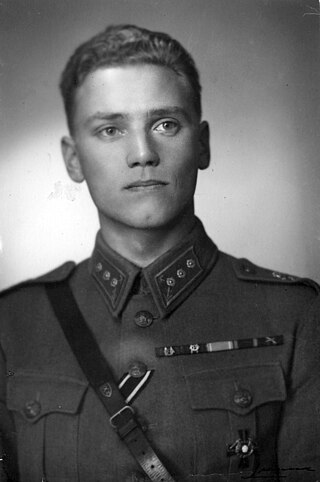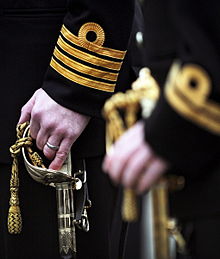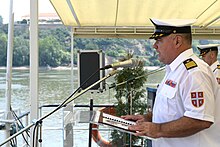Commodore is a senior naval rank used in many navies which is equivalent to brigadier or brigadier general and air commodore. It is superior to a navy captain, but below a rear admiral. It is either regarded as the most junior of the flag officers rank or may not hold the jurisdiction of a flag officer at all depending on the officer's appointment. Non-English-speaking nations commonly use the rank of flotilla admiral, counter admiral, or senior captain as an equivalent, although counter admiral may also correspond to rear admiral lower half abbreviated as RDML.
Admiral is a military rank, typically the highest or among the highest flag officers in a navy. In the armed forces of the United States and Commonwealth of Nations, an admiral—sometimes clarified as a "full admiral"—is the equivalent of a general in the army or air force. NATO codes place admirals or their equivalents at OF-9, behind only the infrequently awarded rank of fleet admirals (US) or admirals of the fleet (CON) and just above vice-admirals. In premodern contexts, admiral is also used as an informal rank for any commander-in-chief of a navy or major fleet.
Vice admiral is a senior naval flag officer rank, usually equivalent to lieutenant general and air marshal. A vice admiral is typically senior to a rear admiral and junior to an admiral.
A lieutenant is a junior commissioned officer rank in the armed forces of many nations, as well as fire services, emergency medical services, security services and police forces.
First lieutenant is a commissioned officer military rank in many armed forces; in some forces, it is an appointment.
Ensign is a junior rank of a commissioned officer in the armed forces of some countries, normally in the infantry or navy. As the junior officer in an infantry regiment was traditionally the carrier of the regimental colours, the rank acquired the name. This rank has generally been replaced in army ranks by second lieutenant. Ensigns were generally the lowest-ranking commissioned officer, except where the rank of subaltern existed. In contrast, the Arab rank of ensign, لواء, liwa', derives from the command of units with an ensign, not the carrier of such a unit's ensign, and is today the equivalent of a major general.
Counter admiral is a rank found in many navies of the world, but no longer used in English-speaking countries, where the equivalent rank is rear admiral. The term derives from the French contre-amiral. Depending on the country, it is either a one-star or two-star rank.
Captain lieutenant or captain-lieutenant is a military rank, used in a number of navies worldwide and formerly in the British Army.
Senior captain is a rank which is used in some countries' armed forces, navies, merchant marines, civil aviation and in the airline industry.
Captain-commandant is a rank currently used in the Belgian Armed Forces and formerly used in the United States Revenue Cutter Service and its successor, the United States Coast Guard.

The army rank of captain is a commissioned officer rank historically corresponding to the command of a company of soldiers. The rank is also used by some air forces and marine forces, but usually refers to a more senior officer. Today, a captain is typically either the commander or second-in-command of a company or artillery battery. In the Chinese People's Liberation Army, a captain may also command a company, or be the second-in-command of a battalion.
Ship-of-the-line lieutenant is a naval officer rank, used in a number of countries. The name derives from the name of the largest class of warship, the ship of the line, as opposed to smaller types of warship.
Corvette captain is a rank in many navies which theoretically corresponds to command of a corvette. The equivalent rank is lieutenant commander in the Royal Navy and other Commonwealth navies, lieutenant commander in the United States Navy, and lieutenant-commander in the Royal Canadian Navy – a bilingual country which actually uses the term capitaine de corvette (capc) for the rank of lieutenant-commander when written or spoken in French.
Frigate captain is a naval rank in the naval forces of several countries. Corvette captain lies one level below frigate captain.
Frigate lieutenant is a naval rank in the naval forces of several countries.
Lieutenant (abbreviated Lt, LT (U.S.), LT(USN), Lieut and LEUT, depending on nation) is a commissioned officer rank in many English-speaking nations' navies and coast guards. It is typically the most senior of junior officer ranks. In most navies, the rank's insignia may consist of two medium gold braid stripes, the uppermost stripe featuring an executive curl in many Commonwealth of Nations; or three stripes of equal or unequal width.
The Military ranks of Nicaragua are the military insignia used by the Nicaraguan Armed Forces.
Captain is a title, an appellative for the commanding officer of a military unit; the supreme leader of a navy ship, merchant ship, aeroplane, spacecraft, or other vessel; or the commander of a port, fire or police department, election precinct, etc. In militaries, the captain is typically at the level of an officer commanding a company or battalion of infantry, a ship, or a battery of artillery, or another distinct unit. It can also be a rank of command in an air force. The term also may be used as an informal or honorary title for persons in similar commanding roles.
Rank comparison chart of navies of North and South American states.
Rank comparison chart of navies of North and South American states.









































